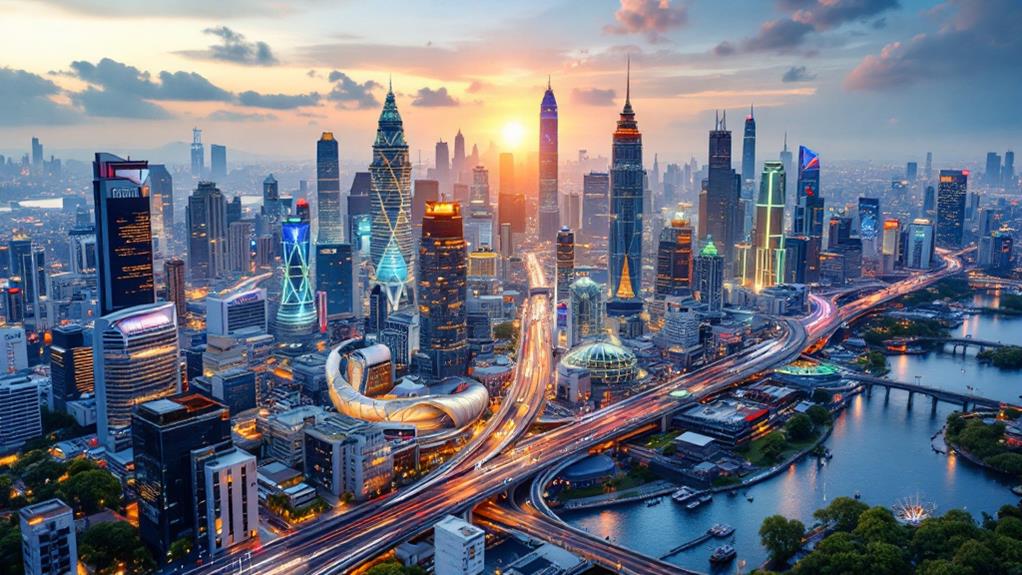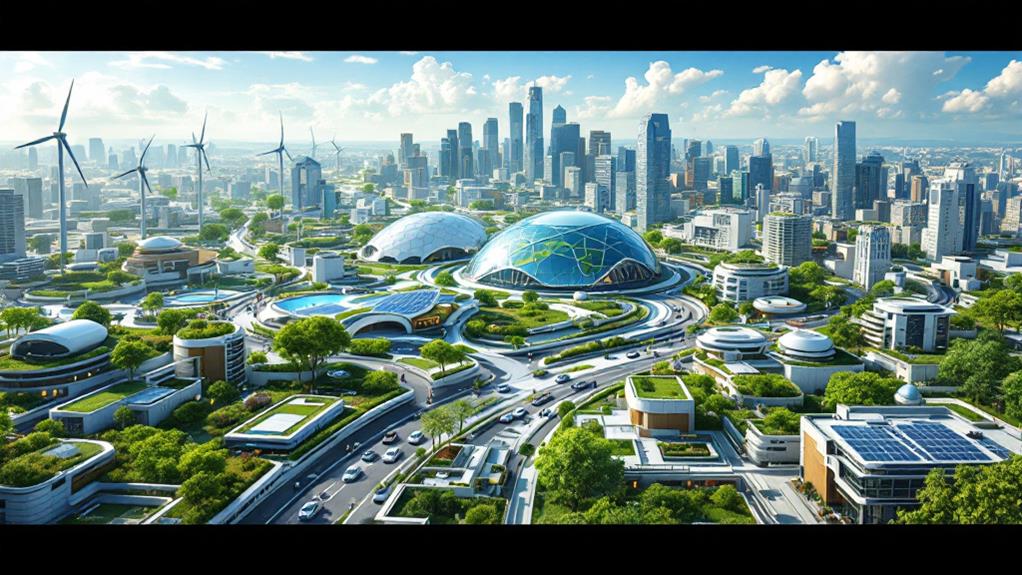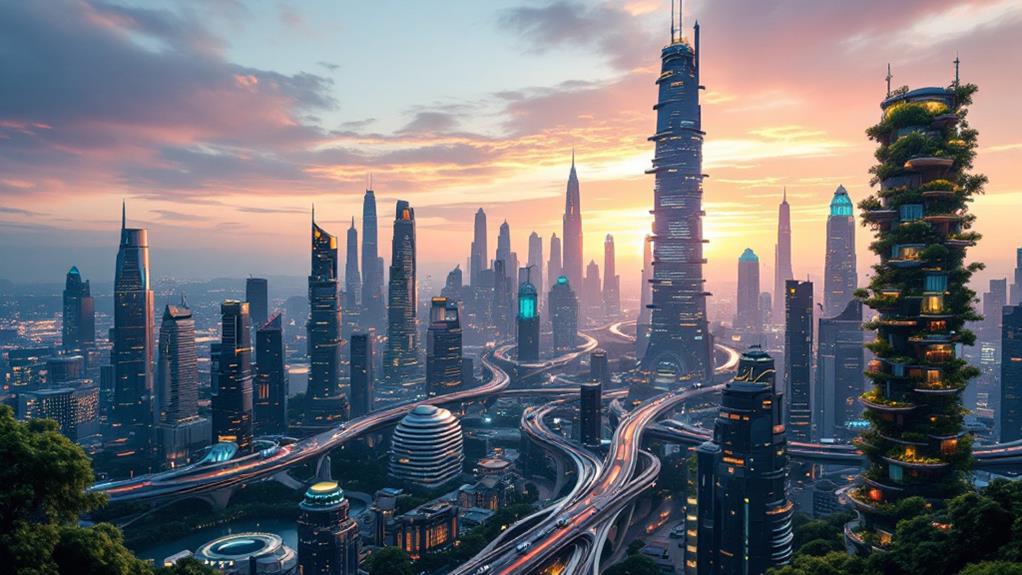How the Largest Urban Areas Are Shaping Global Development

You're seeing how the largest urban areas are transforming global development with their significant economic contributions and cutting-edge infrastructures. These cities drive over 80% of the world's GDP, making them crucial for economic growth. Despite challenges like urban sprawl and climate risks, they're leading in sustainable development through smart city solutions and digital governance. However, they also face issues of inequality and climate vulnerability. By overcoming these, cities can bolster poverty alleviation and improve resilience. As you investigate further, you'll find how urban planning is integrating technology and sustainable practices to balance growth and equity.
Urbanization Trends and Challenges
Urbanization is frequently seen as a hallmark of modern development, yet it presents significant challenges that can't be overlooked. As more people flock to urban areas, currently home to 56% of the global population, the pressure on infrastructure and services intensifies. Urban land consumption is growing 50% faster than population growth, leading to urban sprawl that complicates efforts to create sustainable cities. You're witnessing a landscape where nearly 1 billion people live in informal settlements, grappling with urban poverty that reflects the darker side of this growth.
Despite urban areas being engines of economic growth, they also exacerbate climate change, contributing to over 70% of global greenhouse gas emissions. This duality requires balancing development with environmental stewardship. The vulnerability of urban populations is further highlighted as approximately 1.81 billion people live in high-risk flood zones, emphasizing the urgent need for resilient infrastructure.
As urbanization shapes global development, addressing the challenges posed by urban poverty, climate change, and rapid land consumption becomes imperative. Sustainable cities must prioritize equitable access to resources and services, ensuring that urban growth doesn't come at the cost of the environment or social equity.
Economic Impact of Urban Areas
When you think about the lively energy of cities, it's clear they're not just centers of population but also the engines powering global economies. Urban areas house 56% of the global population and generate more than 80% of global GDP. This significant economic impact highlights their role in driving both national and international growth. As urban population growth continues, with projections reaching over 7 billion by 2050, cities face challenges in maintaining efficient urban infrastructure and addressing spatial inequalities.
Urban land consumption is outpacing population growth by 50%, leading to sprawling cities. This sprawl can hinder economic efficiency and complicate resource allocation. The informal economy, vital yet vulnerable, supports around 2 billion workers in cities. These workers often lack access to social protections, presenting a challenge to sustainable development.
Moreover, urban areas account for over 70% of global greenhouse gas emissions, linking economic activities with environmental sustainability challenges. As you consider economic recovery strategies, addressing these emissions is essential. Cities need to balance growth with sustainable development goals, ensuring that economic activities don't further exacerbate environmental issues. By focusing on these challenges, you can better understand the economic dynamics shaping the future of urban areas.
Strategies for Sustainable Development

Sustainable development strategies in urban areas are fundamental for ensuring cities thrive economically while minimizing environmental impacts. You can help shape the future by focusing on enhancing urban infrastructure and investing in sustainable urban development. The World Bank invests $5 billion annually in urban projects, emphasizing the significance of integrated approaches that improve urban planning systems and local capacities. By prioritizing inclusive growth, especially in low-income urban communities, you contribute to a more equitable society.
Disaster resilience is another important component. Over 140 countries have received support to bolster urban infrastructure against natural disasters, with $4 billion allocated to disaster risk management in FY21. Financial investment in initiatives like the City Resilience Program helps mobilize capital for climate and disaster resilience projects, ensuring urban areas can withstand future challenges.
Low-carbon strategies are critical for shifting cities towards sustainable futures. The City Climate Finance Gap Fund plays a fundamental role by assisting cities in developing these strategies, which require significant financial resources. By embracing integrated approaches that address planning, land access, infrastructure, and financing, you support climate resilience and foster a sustainable urban environment for future generations.
Climate Change and Resilience
Addressing climate change and building resilience in urban areas is vital for shaping a sustainable future. With urban areas responsible for over 70% of global greenhouse gas emissions, you play an important role in climate change mitigation. Cities, which generate more than 80% of global GDP, hold significant economic power, making the shift to low-carbon economies not only necessary but also potentially profitable.
To improve urban resilience, consider the following:
- Invest in disaster risk management: This is fundamental as over 1.81 billion people live in high-risk flood zones.
- Prioritize effective urban planning: Create climate-resilient infrastructure to prevent up to 100 million urban residents from falling back into poverty by 2030.
- Focus on reducing greenhouse gas emissions: Given their significant contribution, urban areas need targeted strategies.
- Support poverty alleviation initiatives: Climate change can exacerbate urban poverty, so addressing it is key.
- Recognize economic significance: Utilize the economic power of cities to fund sustainable projects.
Addressing Urban Inequality

In tackling urban inequality, it's essential to acknowledge the disparity in access to fundamental services, which leaves millions in slums without basic needs. Approximately 1.1 billion people live in informal settlements, and with rapid urbanization, this number could rise by another 2 billion in the next 30 years. Urban areas, especially in the Global South, face severe challenges as up to 70% of their populations are underserved by municipal infrastructure. This lack of access to crucial services like housing, sanitation, and healthcare exacerbates urban poverty and traps marginalized communities in cycles of deprivation.
COVID-19 has further highlighted these vulnerabilities, pushing millions into urban poverty and revealing the precariousness of informal workers, who are vital to urban economies. As urban areas generate over 80% of global GDP, they must address these inequities to guarantee sustainable development. Urban inequality is not only a social issue but is also intertwined with environmental challenges, as cities account for nearly 70% of greenhouse gas emissions. By focusing on improving access to services and integrating sustainable practices, cities can reduce urban poverty and create more equitable opportunities for all residents, fostering resilience and growth in urban areas.
Infrastructure and Technology Innovations
Tackling urban inequality requires forward-thinking solutions that harness the potential of infrastructure and technology advancements. Urban areas are at the forefront of this transformation, accounting for over 70% of global greenhouse gas emissions. To address this, cities are integrating sustainable practices into their infrastructure. The smart city solutions market is booming, with a projected annual growth of 25%, set to reach $517 billion. This growth underscores the critical role of technology in creating sustainable urban environments.
To foster these advancements, you should focus on:
- Investing in low-carbon infrastructure to reduce emissions and promote sustainability.
- Enhancing digitalization in urban governance to improve service delivery, while ensuring it doesn't widen socioeconomic inequalities.
- Training municipal officials through initiatives like the City Creditworthiness Initiative to secure funding for crucial infrastructure projects.
- Leveraging creative financing mechanisms such as those supported by the World Bank's $33.9 billion urban projects portfolio.
- Cultivating inclusive urban areas that balance growth with equitable access to technology and resources.
Future of Global Urbanization

By 2050, more than 7 billion people will call urban areas home, driving a massive shift in global development and resource allocation. As the urbanization process accelerates, cities will remain essential to the global population's economic growth, generating over 80% of the world's GDP. However, sprawling urban areas are expanding 50% faster than their population growth, which may worsen inequality and environmental challenges. You must consider how this affects the urban poor, especially the 1 billion individuals living in informal settlements.
To address these issues, sustainable urban planning becomes vital. Cities are responsible for over 70% of greenhouse gas emissions, making climate change resilience a top priority. You need to advocate for integrated solutions that incorporate sustainable development and equitable access to urban infrastructure. By focusing on inclusive policies, you can help mitigate the impact of urbanization on the environment and reduce the gaps between different socioeconomic groups.
The future of global urbanization lies in balancing economic growth with social equity and environmental stewardship. By embracing sustainable practices and prioritizing inclusive urban development, you can help shape cities that are resilient, fair, and capable of thriving amid the challenges ahead.



